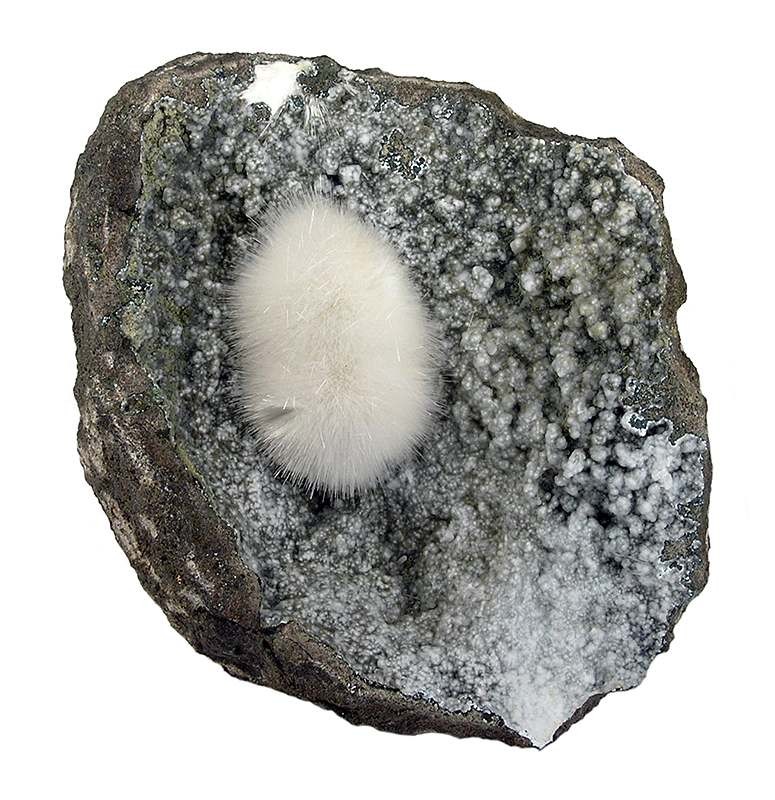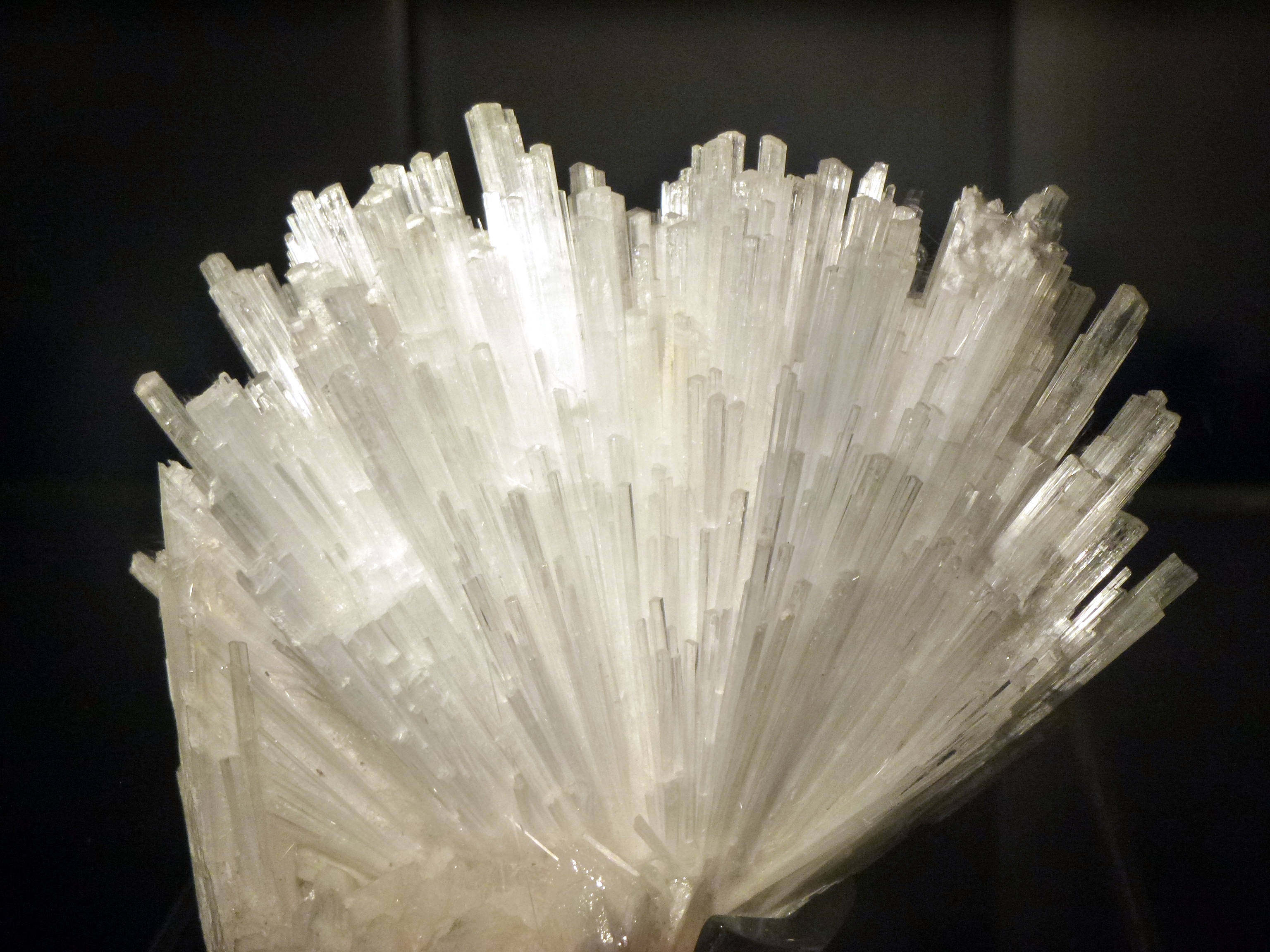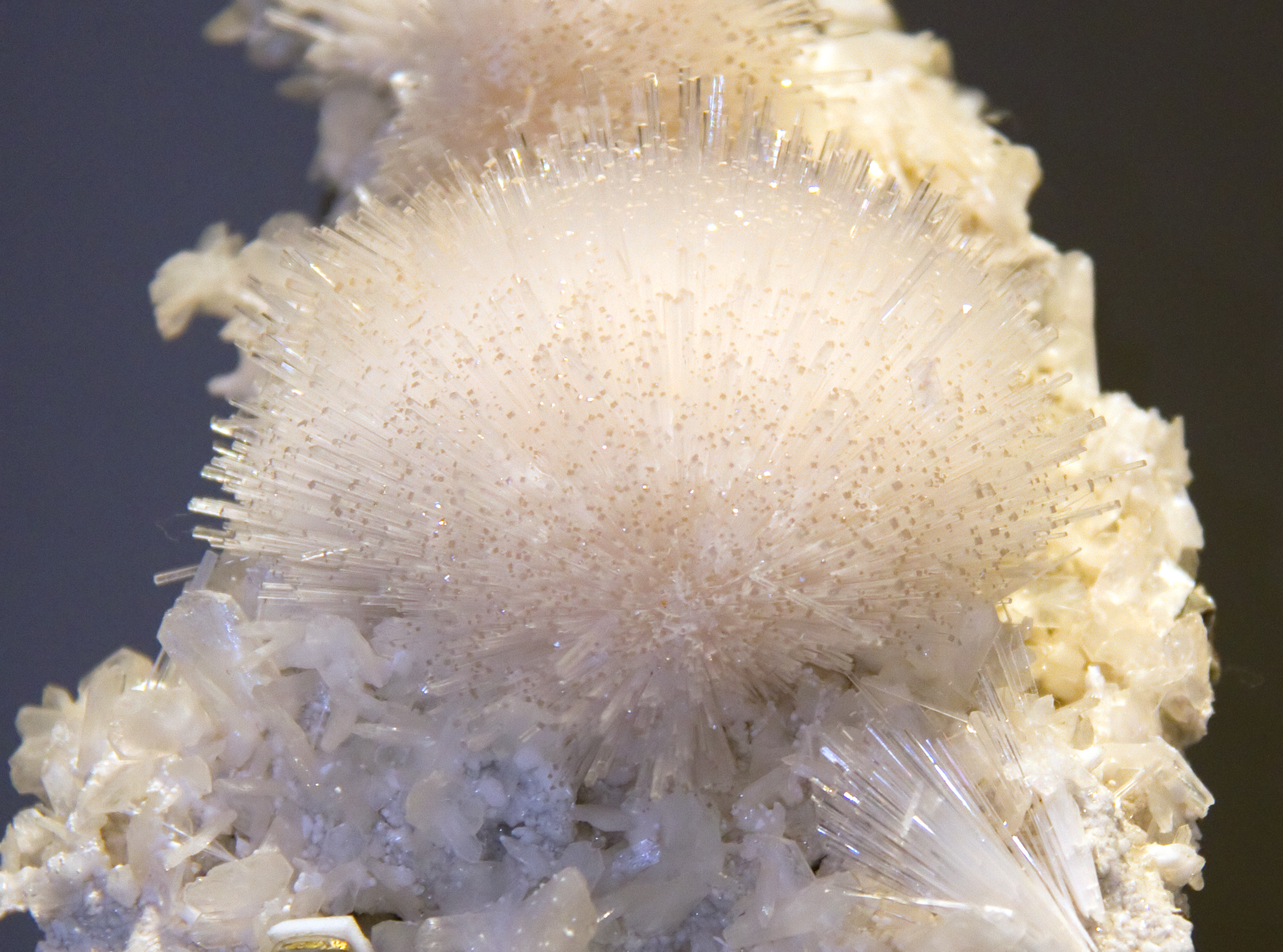
Mesolite Gemstone: Properties, Meanings, Value & More
 Mesolite (mee-soh-lite) is a delicate variety of zeolite known for its impressive natural crystal formations and potential “cat’s eye” effect. The mineral is closely related to the stones natrolite and scolecite.
Mesolite (mee-soh-lite) is a delicate variety of zeolite known for its impressive natural crystal formations and potential “cat’s eye” effect. The mineral is closely related to the stones natrolite and scolecite.
Is mesolite rare? As a mineral, mesolite is fairly common. But large crystal specimens are very rare, and most cut pieces are small. Faceted mesolite gemstones are scarce to non-existent.
Plus, mesolite is very fragile, and many attractive crystal specimens are difficult to find or transport intact. This only adds to the appeal of gorgeous, intact specimens, especially among collectors.
Join us as we go over mesolite’s properties, history, prices, and more in this guide!
 Image credit: The High Fin Sperm Whale, CC-BY-SA-3.0
Image credit: The High Fin Sperm Whale, CC-BY-SA-3.0
About Mesolite Stone
Mesolite is a semi-precious gemstone, though it’s rarely found as faceted gems.
What does mesolite look like? Color-wise, it’s usually colorless or white, though sometimes pale yellow. Often, mesolite is found as narrow, acicular (needle-like) crystals.
Other terms for mesolite include:
Mésotype
Lime-Soda-Mesotype
Verrucite
Haringtonite (mixture of mesolite and thomsonite)
Cotton-Stone (for crystal clusters resembling cotton balls)
Poonahlite / Punahlite / Poonalite (after source in Pune, India)
Needle Zoisite / Needle Stone
The first and last names in the list above are used for mesolite, natrolite, and scolecite.
Mesolite Uses
Zeolites like mesolite are often used commercially as catalysts, adsorbers, and ion exchange materials.
Certain types of mesolite, sometimes produced synthetically, are useful as catalysts, like one-pot synthesis of 2-amino-4H-chromenes (compounds with various biological and medical applications).
Scientists have also created synthetic mesolite analogues to remove hazardous materials like uranium, thorium, and europium from liquid (aqueous) waste.
 Pictured above: Mesolite "puff ball" on quartz in basaltic vug | Image credit: Rob Lavinsky, iRocks.com – CC-BY-SA-3.0
Pictured above: Mesolite "puff ball" on quartz in basaltic vug | Image credit: Rob Lavinsky, iRocks.com – CC-BY-SA-3.0
Mesolite Specifications & Characteristics
Natrolite is a hydrated sodium calcium aluminum tectosilicate with the formula Na2Ca2Si9Al6O30.8H2O. Potassium is a common impurity.
The stone belongs to the natrolite subgroup of the larger zeolite mineral group. Other minerals in this subgroup are gonnardite, paranatrolite, natrolite, and scolecite.
Among these, the most important are mesolite, natrolite, and scolecite. These form a series, with natrolite on the sodium-dominated end, scolecite on the calcium-dominated end, and mesolite in the middle. Mesolite’s calcium to sodium ratio is always around 1:1.
The most common crystal habits for mesolite are elongated prismatic or acicular (needle-like) crystals. The crystals are often found in sprays (fibrous or hair-like), tufts or ”puffs”, and spherical aggregates, sometimes inside geodes. The mineral can also form tougher, compact masses.
Mesolite’s properties listed:
Mohs hardness: 5
Color: Colorless, white, gray, light yellow
Crystal structure: Orthorhombic
Luster: Vitreous, silky if fibrous
Transparency: Transparent to opaque
Refractive index: 1.504-1.508
Density: 2.26-2.40
Cleavage: Perfect on {110} and {110}
Fracture: Uneven/irregular
Streak: White
Luminescence: Fluorescence sometimes present - Pink (Indian specimens), cream, or white (Colorado specimens) in LW-UV
Pleochroism: None or unobservable
Birefringence: 0.001
Dispersion: Strong
Optical effects: Chatoyancy possible
 Pictured above: Scolecite cabochon
Pictured above: Scolecite cabochon
Mesolite vs Natrolite vs Scolecite
Besides belonging to the zeolite group and natrolite subgroup, mesolite, natrolite, and scolecite have many other traits in common, like:
Crystal Habit: Elongated crystals
Color: Usually colorless to white
Tenacity: Brittle; Compact masses tougher
Optic Axes: Biaxial
So, what is the difference between scolecite and mesolite and natrolite?
Crystal System: Mesolite and natrolite are orthorhombic. Scolecite is monoclinic. Scolecite and natrolite can be pseudo-tetragonal.
Refractive Indices: Natrolite - 1.473-1.495 (lowest); Mesolite - 1.504-1.508; Scolecite - 1.509-1.525 (highest)
Density: Natrolite and mesolite are very similar at 2.0 to 2.26, but scolecite has a wider range of 2.21 to 2.29.
Optic Angle: 2V of scolecite - 36-56° (lowest); 2V of natrolite - 58-64°; 2V of mesolite - around 80° (highest)
Optic Sign: Mesolite and natrolite are biaxial positive. Scolecite is biaxial negative.
Birefringence: Mesolite - 0.001 (lowest); Scolecite - 0.007-0.012; Natrolite - 0.013 (highest)
Rarity: Facetable natrolite crystals are the most common of the group. Facetable scolecite crystals are rare, and facetable mesolites are virtually non-existent. Natrolite is a very common zeolite, scolecite is an uncommon zeolite, and mesolite is fairly rare.
Additionally, a visual difference between mesolite vs scolecite or natrolite is that the needle-like crystals of mesolite are narrow, while those of natrolite and scolecite are wider.
 Pictured above: Mesolite needles set in a thomsonite-covered vug in basalt matrix | Image credit: Rob Lavinsky, iRocks.com – CC-BY-SA-3.0
Pictured above: Mesolite needles set in a thomsonite-covered vug in basalt matrix | Image credit: Rob Lavinsky, iRocks.com – CC-BY-SA-3.0
Mesolite History
When was mesolite discovered? The first description of mesolite was published in 1801, but not as its own species. The description came from French mineralogist René Just Haüy, and he called mesolite, natrolite, and scolecite “mésotype.”
While German chemist Martin Heinrich Klaproth described natrolite in 1810, mesolite (and scolecite) weren’t recognized as their own species until 1813.
In 1813, German chemists Adolph Ferdinand Gehlen and Johann Nepomuk von Fuchs published “About Werner's zeolite, Hauy's mesotype and stilbite” in the Journal of Chemistry and Physics (translated from German).
Their article didn’t specify a source, but Fuchs published another article in 1816 with his analysis of mesolite and scolecite from the Faröe Islands (Denmark) and Iceland. This analysis also clarified distinctions between mesolite, natrolite, and scolecite.
The name “mesolite” derives from the Greek meso, meaning “middle,” referencing its composition being between natrolite and scolecite.
Mesolite Healing Properties
As a primarily colorless healing stone, mesolite’s meaning reflects that of other colorless gems, offering cleansing and nurturing energies. It’s also a powerful crown chakra stone.
Physical Healing
Physically, mesolite benefits are said to include treating:
Bloating
Drug withdrawal
Blood clotting
Wound or illness recovery
Emotional Healing
Crystal healers recommend mesolite for improving relationships and soothing negative feelings. Zeolites like mesolite are said to boost motivation while keeping you grounded, balanced, and refreshed.
 Image credit: Pascal Terjan, CC-BY-SA-2.0
Image credit: Pascal Terjan, CC-BY-SA-2.0
Mesolite Gemstone Properties
Besides rarity, the value factors for mesolite gems are color, cut, clarity, and carat weight.
Color
Most mesolite crystals are colorless to white, but pale yellow ones may be more valuable. Some in Yellow Lake, Canada, were even pink, salmon-orange, and dark red, possibly from impurities.
Cut
Scolecite and natrolite may be faceted (almost always into long step- or emerald-cuts), but faceted mesolites are extremely rarely, if ever, seen.
Fibrous mesolite specimens displaying chatoyancy must be cut into cabochons to display this optical effect.
Most often, attractive mesolite specimens are sold rough (uncut). Many of these specimens are on a matrix, like mesolite on thomsonite. Since most have a matrix in a similarly white or pale color, the most valuable ones have a strong contrasting color, like white mesolite on vibrantly colored stilbite.
Clarity & Transparency
Clarity, the degree of visible inclusions, can affect a stone’s transparency and value. Mesolites with greater transparency and fewer inclusions can be more valuable.
Mesolite is also found as an inclusion in diopside and quartz.
Size
Large, transparent mesolite crystals haven’t been found yet. Even the more common fibrous material only yields small cabochons.
 Pictured above: Mesolite needles on analcime crystals | Image credit: John Sobolewski, CC-BY-SA-3.0
Pictured above: Mesolite needles on analcime crystals | Image credit: John Sobolewski, CC-BY-SA-3.0
Mesolite Formation & Sources
Most zeolites are secondary minerals, forming when external conditions alter primary minerals inside a rock into new (secondary) minerals.
Zeolite minerals often follow a sequence, with one altering to the next. In volcanic rocks, thomsonite can alter into mesolite, which can turn into scolecite.
What type of rock is mesolite found in? Most mesolites are found within cavities of basalts, andesite, porphyrite, and other igneous rocks. Sometimes, they’re found in schists or limestone contact zones.
Mining Locations
Where is mesolite found? The mineral is found in many places, but only some have large crystals or masses:
Australia
Canada
France
Iceland
India
Italy
Faröe Islands
USA (Colorado, New Jersey, Oregon, Washington)
India is of particular importance, as the Gemological Institute of America (GIA) has identified Indian mesolites as the only type with faceting potential.
 Pictured above: Mesolite, heulandite, and fluorapophyllite-(K) crystal specimen | Image credit: Géry PARENT, CC-BY-SA-4.0
Pictured above: Mesolite, heulandite, and fluorapophyllite-(K) crystal specimen | Image credit: Géry PARENT, CC-BY-SA-4.0
Mesolite Price & Value
Mesolite is almost exclusively available as crystal specimens in various sizes. Many are on a matrix of another mineral like calcite, mordenite, or thomsonite.
The specimens vary widely in price, from $15 to $7,500. The price-per-carat ranges, however, are low, from about $0.05 to $5 per carat.
Most mesolite cabochons are mixtures of mesolite and thomsonite. These are typically $20 to $30, or $0.50 to $1 per carat.
Mesolite Care and Maintenance
Lastly, let’s talk about gemstone care.
First, is mesolite toxic? Fibrous mesolite specimens are considered potentially toxic if you inhale the fibers, so always wear safety materials if handling or cutting them. Polished stones like cabochons are safe to handle.
Additionally, mesolite crystals are extremely fragile, so handle the crystal very gently. We recommend keeping it in a secure display case. Keep mesolite away from extreme heat and hydrochloric acid.
Store separately from other gemstones to avoid scratches.
 Image credit: Tony Hisgett, CC-BY-SA-2.0
Image credit: Tony Hisgett, CC-BY-SA-2.0
Mesolite: A Rare Mineral Worthy of Attention!
Though its plain white coloring may seem unassuming, mesolite is beloved for its marvelous crystal formations and rarity. Like lace or fine china, mesolite’s delicacy only adds to its appeal.
Search the Gemstone Encyclopedia
Related Auctions
Related Articles
Originally the Birthstones or gemstones were associated with a zodiac sign or the month of a individuals birth. Find out what your stone is and view the stones we have for sale
8th Feb 2021
There are dozens of quartz and chalcedony gems with various colors and patterns. Learn all about quartz properties and every type of quartz, from amethyst and agate to plasma and phantom quartz!
15th Oct 2020
Hackmanite is a pink to violet sodalite gem known for its unique color-change and luminescence. Learn why hackmanite is special, from its rare qualities to the types of hackmanite jewelry available.
28th Mar 2018
Latest Articles
Catapleiite is a lesser-known mineral and rare gemstone often found as stunning tabular rosettes near other rare stones. Discover the history, prices, benefits, and properties of catapleiite!
28th Apr 2025
Yugawaralite is a rare colorless, white, or pinkish zeolite crystal named for its discovery in Yugawara, Japan. Here we uncover the multifaceted history, properties, prices, and uses of yugawaralite.
24th Mar 2025
Simpsonite is a lesser-known mineral known on the gem market for its durability, yellow-orange color, and rarity. Discover all the properties, uses, prices, and history of simpsonite.
3rd Mar 2025
Article Categories
How To's is where you will find helpful articles from gem Rock Auctions on how to cut gemstones, select gemstones and buy gemstones.
9 Articles




